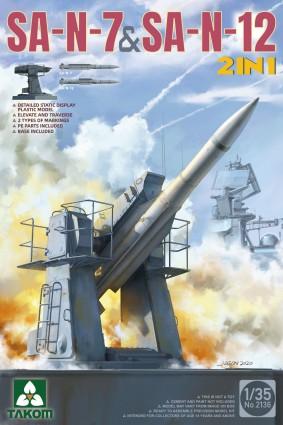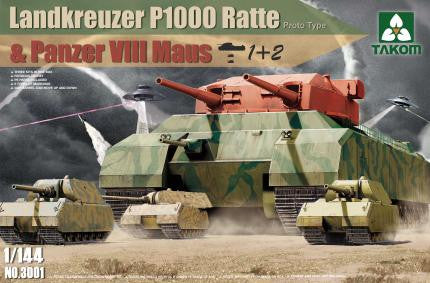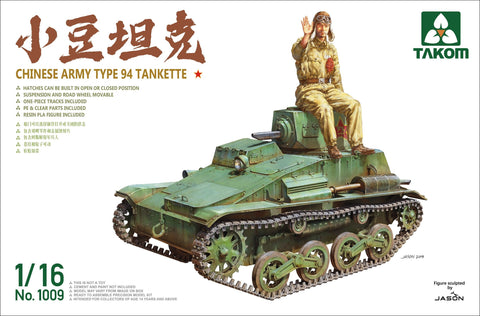
Takom 1/35 WWII German Maus V1 Super Heavy Tank (New Tool) Kit
This Product Usually Ships In 2-3 Business Days
TAK-2049The heaviest tank ever to be constructed was Germany’s Panzer VIII. Its designers weren’t without a sense of humor – they named the 180-ton behemoth the "Maus". Had the Maus’ manufacturing plant not been bombed by the allies and subsequently overrun by the Soviets in 1945, the Germans would have built more than just the single fully operational prototype. The Maus was intended to punch holes through enemy defenses in the manner of an immense "breakthrough tank", whilst taking almost no damage to any components or the crew inside.
The complete vehicle was 10.2 meters (33 ft 6 in) long, 3.71 meters (12 ft 2 in) wide and 3.63 metres (11.9 ft) high. Weighing 188 metric tons, the Maus's main armament was the Krupp-designed 128 mm KwK 44 L/55 gun, based on the 12.8 cm Pak 44 anti-tank field artillery piece also used in the casemate-type Jagdtiger tank destroyer, with a coaxial 75 mm KwK 44 L/36.5 gun. The 128 mm gun was powerful enough to destroy all Allied armored fighting vehicles previously in service, some at ranges exceeding 3,500 meters (3,800 yds).
The armor on the hull front was 220 millimeters (8.7 in) thick, the sides and rear of the hull were up to 190 millimeters (7.5 in). The turret armor was even thicker, the turret front was up to 240 millimeters (9.4 in) and the sides and rear 200 millimeters (7.9 in). The gun mantlet was 250 millimeters (9.8 in), and combined with the turret armor behind, the protection level at that section was even higher.
The first, turretless prototype (V1) was assembled by Alkett in December 1943. Tests started the same month, with a mockup turret fitted of the same weight as the real turret. In June 1944 the production turret, with armament, was used for tests.
The Maus was too heavy to cross bridges. As a result, an alternative system was developed, where the Maus would instead ford the rivers it needed to cross. Due to its size, it could ford relatively deep streams, but for deeper ones, it was to submerge and drive across the river bottom. The solution required tanks to be paired up. One Maus would supply electrical power to the crossing vehicle via a cable until it reached the other side. The crew would receive air through a large snorkel, which was long enough for the tank to go 7.9 m (26 ft) under water.
The complete vehicle was 10.2 meters (33 ft 6 in) long, 3.71 meters (12 ft 2 in) wide and 3.63 metres (11.9 ft) high. Weighing 188 metric tons, the Maus's main armament was the Krupp-designed 128 mm KwK 44 L/55 gun, based on the 12.8 cm Pak 44 anti-tank field artillery piece also used in the casemate-type Jagdtiger tank destroyer, with a coaxial 75 mm KwK 44 L/36.5 gun. The 128 mm gun was powerful enough to destroy all Allied armored fighting vehicles previously in service, some at ranges exceeding 3,500 meters (3,800 yds).
The armor on the hull front was 220 millimeters (8.7 in) thick, the sides and rear of the hull were up to 190 millimeters (7.5 in). The turret armor was even thicker, the turret front was up to 240 millimeters (9.4 in) and the sides and rear 200 millimeters (7.9 in). The gun mantlet was 250 millimeters (9.8 in), and combined with the turret armor behind, the protection level at that section was even higher.
The first, turretless prototype (V1) was assembled by Alkett in December 1943. Tests started the same month, with a mockup turret fitted of the same weight as the real turret. In June 1944 the production turret, with armament, was used for tests.
The Maus was too heavy to cross bridges. As a result, an alternative system was developed, where the Maus would instead ford the rivers it needed to cross. Due to its size, it could ford relatively deep streams, but for deeper ones, it was to submerge and drive across the river bottom. The solution required tanks to be paired up. One Maus would supply electrical power to the crossing vehicle via a cable until it reached the other side. The crew would receive air through a large snorkel, which was long enough for the tank to go 7.9 m (26 ft) under water.
- Three markings are included
- Photo-Etch parts included







